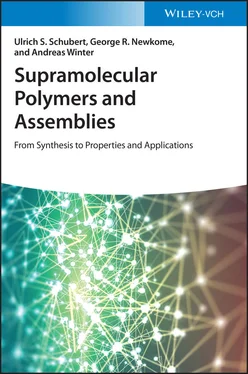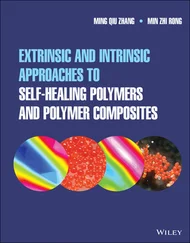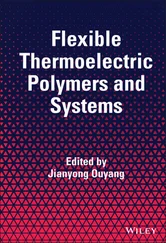4 Chapter 4Figure 4.1 Schematic representation of the general architectures of metal‐containing polymers. Source: Wild et al. [67]. © 2011 The Royal Chemical Society. Figure 4.2 Schematic representation of the three main types of metal‐to‐ligand interactions. (a) Coordinative bonding; (b) ionic bonding; and (c) arene π‐complexation. Source: Refs. [2,46,84].Figure 4.3 Schematic representation of the different general methods utilized for the synthesis of metal‐containing (co)polymers. Source: Refs. [2,61].Figure 4.4 (a) Schematic representation of metal complexes containing pyridine‐based ligands of increasing denticity. (b) The Irving–Williams series.Figure 4.5 Schematic representation of the coordination polymers 1–3showing an increased stability in solution due to enhanced metal‐to‐ligand interactions.Figure 4.6 Schematic representation of the synthesis of the heterobimetallic coordination polymer 4.Figure 4.7 Illustration of the sonication‐induced decrease in the molar mass of 2(1.5 mM in toluene): (a) Molar mass distribution of samples taken during sonication. (b) Evolution of the M Wvalue over five cycles of sonication (1 hour) followed by equilibration (23 hours). Source: Paulusse and Sijbesma [94]. Figure reproduced with kind permission. © 2004 Wiley‐VCH. Figure 4.8 (a) Schematic representation of the synthesis of coordination polymer 5via the coordination of 1,4‐benzenediisocyanide to the [Pt 3(μ 3‐CO)(μ‐dppm) 3] 2+cluster (the counterions are omitted for clarity, L^L: dppm). A representation of the X‐ray single‐crystal structure of the precursor cluster is also shown (here, only the phenyl C‐atoms bonded to each P‐atom are shown for clarity). Source: Bradford et al. [111]. Figure reproduced with kind permission. © 1994 American chemical society.Figure 4.9 Schematic representation of the synthesis of the metallopolymer 7with linear Pt 4clusters within the main chain.Figure 4.10 Schematic representation of the synthesis of coordination polymer 8featuring A‐frame‐units within the backbone.Figure 4.11 Schematic representation of the synthesis of 9, as a polymer‐analogs to cisplatin.Figure 4.12 Schematic representation coordination polymers through the center of the porphyrin rings. (a) Shish‐Kebab‐type assembly, (b and c) assemblies based on AB‐type monomers.Figure 4.13 Schematic representation of Shish–Kebab‐type metallo‐supramolecular polymers 10and 11incorporating phthalocyanine.Figure 4.14 Schematic representation of the synthesis of the metalloporphyrin‐containing polymer 12via a Glaser‐type polyaddition (a) and of the metallo‐supramolecular 2D ladder‐shaped assembly featuring enhanced charge mobility (b). Source: Taylor and Anderson [123]. © 1999 American chemical society.Figure 4.15 Schematic representation of the synthesis of a zigzag‐shaped metallo‐supramolecular coordination polymer. Source: You and Würthner [129]. © 2004 American Chemical Society. Figure 4.16 Schematic representation of the self‐assembly of a 4‐pyridyl‐substituted porphyrin derivative with Zn(II) ions toward 14.Figure 4.17 Schematic representation of the linear Au(I)‐containing metallopolymers 15, which exhibited an odd–even effect with respect to the chain conformation.Figure 4.18 Schematic representation of various metallopolymers containing ditopic NHC‐type ligands. (a) Monodentate and (b) bidentate binding.Figure 4.19 Schematic representation of the synthesis of the rigid metallopolymers 19.Figure 4.20 Schematic representation of the synthesis of the flexible metallo‐supramolecular polymer 20.Figure 4.21 Schematic representation of the synthesis of metallopolymers 21and 23based on tetrahedral bis‐bidentate complexes (a) and a phosphine‐based ligand (b), respectively.Figure 4.22 Schematic representation of the chemical structure of the metallo‐supramolecular polymer 22, an illustration of the proposed helical 3D‐conformation is also shown. Source: Kaes et al. [175]. © 1998 Wiley‐VCH.Figure 4.23 Schematic representation of the metallopolymers 24and 25. The picture shows the green color of 24athat could be changed reversibly to colorless upon electrochemical reduction of the Cu(II) centers. Source: Hossain et al. [181]. Figure reproduced with kind permission. © 2013 Wiley‐VCH.Figure 4.24 Schematic representation of the synthesis of coordination polymers 26and 27containing bridging [Ni(mnt) 2] 2−units.Figure 4.25 Generalized schematic representation of the self‐assembly of ditopic bis‐tridentate ligands and divalent transition metal ions into linear metallo‐supramolecular polymers. Source: Redrawn from Chiper et al. [52]. 2009 John Wiley & Sons.Figure 4.26 Schematic representation of the synthesis of metallopolymers bearing amido‐ or imido‐linkages via two different routes (denoted as methods III and Vb, respectively, see also Figure 4.3).Figure 4.27 Schematic representation of the synthesis of metallo‐supramolecular assemblies from a flexible bis‐terpyridine ligand and Ru(II) ions.Figure 4.28 Schematic representation of the Ru(II)‐containing chain‐extended polymer 31.Figure 4.29 Schematic representation of the general structure of a metallo‐supramolecular homo as well as a diblock copolymer. Source: Redrawn from Schubert et al. [186].Figure 4.30 Schematic representation of the synthesis of polymers equipped with designated metal‐binding sites via the end‐functionalization and the initiator route. Source: Hoogenboom and Schubert [233]. © 2006 The Royal Chemical Society. Figure 4.31 LCST behavior of PNIPAM, tpy‐PNIPAM ( 32), and [Fe( 32) 2]X 2with different counterions X (i.e. Cl −, AcO −, and PF 6 −) in water as monitored by transmittance measurements. Images of the vials below (top) and above the LCST (bottom) are also shown for 32(left) and [Fe( 32) 2] 2+(right). Source: Chiper et al. [239]. © 2008 Wiley‐VCH. Figure 4.32 (a) Transmission electron microscopy (TEM) image of PEG–[Ru]–PS micelles in water (without staining). Source: Lohmeijer et al. [216]. Figure reproduced with kind permission. © 2004 The Royal Chemical SocietyFigure 4.33 Representative AFM images of a spin‐coated film (75 nm thickness) of PS 375–[Ru]–PEG 225on a Si substrate, before (a) and after (b) the removal of the hydrophilic block. (c) XPS signature (C 1sregime) of the film before (solid line) and after treatment with the oxidizing agent. Source: Fustin et al. [220]. Figure reproduced with kind permission. © 2005 Wiley‐VCH.Figure 4.34 Schematic representation of the macroligands 33and 34, which gave an A–[M]–B diblock copolymer in the presence of Zn(II) ions. The diblock copolymer assembled further into spheres and fibers as a function of m / n ratio ( m : length of the PEG block, n : length of the P3HT block). Typical TEM images for both cases (i.e. low and high contents of P3HT, respectively) are also shown. Source: He et al. [247]. Figure reproduced with kind permission. © 2017 American Chemical Society.Figure 4.35 Schematic representation of the synthesis of a metallo‐supramolecular polymer with pending MPEG and poly(2‐diisopropylaminoethyl methacrylate) (PDPA) chains on each repeat unit. This material self‐assembled into striped nanosheets in water. A representative TEM image of such a nanosheet is also depicted. Source: Zhang et al. [250]. Figure reproduced with kind permission. © 2020 The Royal Chemical Society. Figure 4.36 Schematic representation of the metallo‐supramolecular modification of tpy‐functionalized micelles via grafting‐onto and cross‐linking methodologies. Source: Refs. [224,251]. © 2008 and 2009 The Royal Chemical Society. Figure 4.37 Schematic representation of the synthesis of the metallo‐supramolecular ABA‐type triblock copolymers 35.Figure 4.38 Schematic representation of the metallo‐supramolecular polymerization of the ditopic ligand 36in the presence of transition and rare‐earth metal ions. The pictures illustrate the thermoresponsive (a) and the thixotropic behavior (b) of representative combinations of metal ions. Source: Beck and Rowan [253]. Figure reproduced with kind permission. © 2003 American Chemical Society.Figure 4.39 Schematic representation of the metallo‐supramolecular polymerization of rigid bis‐tridentate ligands with Ru(II) ions.Figure 4.40 Schematic representation of the metallo‐supramolecular polymers reported by the Kurth and Higuchi groups. The colors of the metallopolymers in dilute solution are also shown [a: Fe(II), b: Ru(II), and c: Co(II)]. Source: Han et al. [318]. Figure reproduced with kind permission. © 2004 American Chemical Society.Figure 4.41 Representation of the hierarchical self‐assembly of a metallo‐supramolecular polymer by electrostatic self‐assembly processes. (a) Formation of layer‐by‐layer assemblies, (b) formation of core‐shell or hollow particles and (c) formation of metallopolymer‐amphiphile complexes. PSS: poly(styrene sulfonate); PEI: polyethyleneimine; DHP: dihexadecyl phosphonate [298,299,308]. Source: Wild et al. [67]. © 2011 The Royal Chemical Society.Figure 4.42 Schematic representation of selected metallo‐supramolecular polymers assembled from Zn(II) ions and π‐conjugated bis‐terpyridine ligands.Figure 4.43 (a) Mixing triangle of the metallo‐supramolecular polymers 38b, 38c, and 38d. (b) Picture of the corresponding solutions in a quartz microtiter plate (excitation at λ = 365 nm). (c) Position of the observed emission according to the CIE color scheme. Source: Wild et al. [287]. Figure reproduced with kind permission. © 2013 The Royal Chemical Society.Figure 4.44 Schematic representation of the chiral Ru(II)‐ and Fe(II)‐containing metallopolymers 39–42.Figure 4.45 Schematic representation of the bpp‐, btp‐, and pybox‐type ligands 43–46used for the self‐assembly with Fe(II), Eu(III), Ru(II), and Zn(II) ions.Figure 4.46 Schematic representation of the “scorpionate”‐type metallopolymer [Fe( 47)] n, the SEC trace (UV detector) of the purified polymer is also shown. Source: Qin et al. [366]. Figure reproduced with kind permission. © 2012 Wiley‐VCH.Figure 4.47 Schematic representation of the general structure of poly(metal acetylide)s and poly(metal arylide)s.Figure 4.48 Schematic representation of the polyplatinyne synthesis, according to Hagihara's original protocol.Figure 4.49 Schematic representation of selected examples of polyplatinynes highlighting the broad structural diversity reported in literature.Figure 4.50 Schematic representation of the poly(metal acetylide)s synthesis via metathesis reactions: (a) classical route and (b) extended one‐pot route.Figure 4.51 Schematic representation of Puddephatt's synthesis of Au(I)‐containing polymers 49and 50.Figure 4.52 Schematic representation of the Au(I)‐containing monomer 51which assembled into supramolecular fibers due to aurophilic and H‐bonding interactions. A representative TEM image of the obtained fiber network is also shown. Source: Chen et al. [405]. Figure reproduced with kind permission. © 2017 The Royal Chemical Society.Figure 4.53 Schematic representation of metallo‐supramolecular polymers based on pincer‐type binding motives according to (a) Loeb and Shimidzu [408] was well as (b) van Koten et al. [409].Figure 4.54 Schematic representation of two coordination polymers based on Pd(II)‐pincer complexes according to the Craig ( 51) and the Weck groups ( 52), respectively.Figure 4.55 (a) Schematic representation of the proposed synthesis of metallopolymer 56featuring pincer‐type coordination and carbon‐to‐metal bonds. (b) Schematic representation of the metallopolymer 57featuring bis(triazol‐4‐yl)pyridine coordination and carbon‐to‐metal bonds; a representation of the 3D SEC analysis is also depicted. Source: Schulze et al. [416]. Figure reproduced with kind permission. © 2017 American Chemical Society.Figure 4.56 (a) Schematic representation of metallo‐supramolecular polymers 58, based on Zn(II)‐dpm bis‐complexes. (b) Scanning electron microscopy (SEM) images of the assembly 58containing an angular ligand in THF (top, inset: 25 μm × 25 μm fluorescence micrograph) and from a 2 : 1 THF/water mixture (bottom). Source: Maeda et al. [419]. Figure reproduced with kind permission; © 2006 American Chemical Society.Figure 4.57 Schematic representation of the Cu(II)‐containing chain‐extended polymers 59showing LC behavior.Figure 4.58 Schematic representation of the synthesis of linear and branched coordination polymers, incorporating luminescent Znq 2‐ or Alq 3‐type complexes.Figure 4.59 Schematic representation of metallo‐supramolecular polymers 61and 62.Figure 4.60 Schematic representation of metallo‐supramolecular polymers, based on salen ( 63) and catechol bis‐complexes ( 64).Figure 4.61 Structural characteristics of the coordination assemblies obtained from Ln(III) ions and 65, as a function of the concentration. Source: Vermonden et al. [443]. Figure reproduced with kind permission; © 2004 Wiley‐VCH.Figure 4.62 Schematic representation of the ditopic ligand, which was used for the complexation of Eu(III) ions. Photographs of the free‐standing K n[Eu( 66)] npolymer film upon excitation with 365‐nm‐light – under NEt 3vapor and upon exposure to HCl gas – are also shown. The comparison of the photoluminescence intensity reveals the switchability between the “ON” and “OFF” state. Source: Sato and Higuchi [445]. Figure reproduced with kind permission. © 2012 The Royal Chemical Society.Figure 4.63 Schematic representation of the synthesis of a white‐light‐emitting heterobimetallic supramolecular polymer. Source: Sato and Higuchi [448]. Figure reproduced with kind permission. © 2019 Elsevier B.V.Figure 4.64 (a) Schematic representation of the heterobimetallic coordination polymer 68. (b) Schematic representation of the tetrathiolate‐based metallopolymers 69and their electric conductivities.Figure 4.65 Schematic representation of typical polymetallocene structures.Figure 4.66 Schematic representation of the synthesis of the ferrocene‐containing polymers 70(a) and 71(b) by a metallo‐supramolecular polymerization. Source: Refs [465,466].Figure 4.67 Schematic representation of the generalized structures of polydecker sandwich complexes (Types A and B) as well as linear polymetallocenes (Types C and D). Source: Redrawn from Manners [41].Figure 4.68 Schematic representation of the synthesis of type‐A polydecker complexes incorporating (a) Ni(II) ( 72) and (b) Rh(II) centers ( 73). Figure 4.69 Schematic representation of the oligometallocene 74.Figure 4.70 Schematic representation of the synthesis of the homo‐ and heterometallic polydecker assemblies 75.Figure 4.71 Schematic representation of the type‐C polymetallocene 76.
Читать дальше












